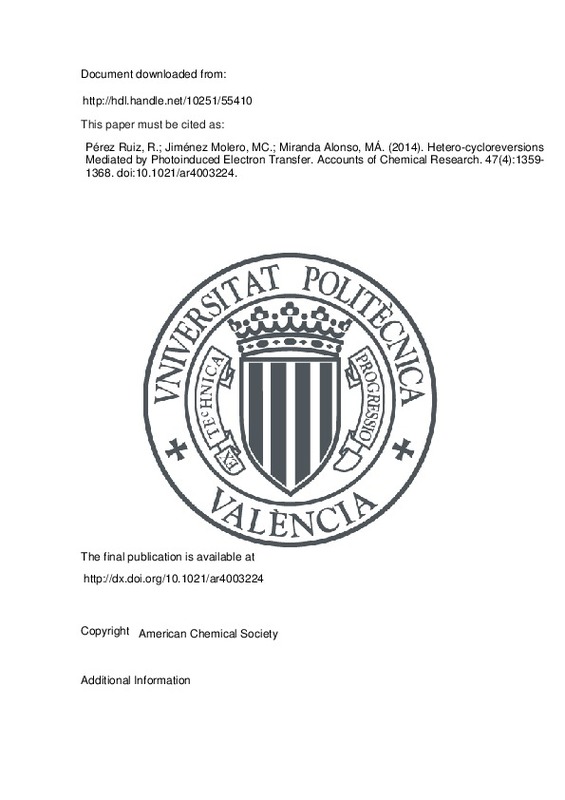JavaScript is disabled for your browser. Some features of this site may not work without it.
Buscar en RiuNet
Listar
Mi cuenta
Estadísticas
Ayuda RiuNet
Admin. UPV
Hetero-cycloreversions Mediated by Photoinduced Electron Transfer
Mostrar el registro sencillo del ítem
Ficheros en el ítem
| dc.contributor.author | Pérez Ruiz, Raul
|
es_ES |
| dc.contributor.author | Jiménez Molero, María Consuelo
|
es_ES |
| dc.contributor.author | Miranda Alonso, Miguel Ángel
|
es_ES |
| dc.date.accessioned | 2015-10-01T10:51:35Z | |
| dc.date.issued | 2014-04 | |
| dc.identifier.issn | 0001-4842 | |
| dc.identifier.uri | http://hdl.handle.net/10251/55410 | |
| dc.description.abstract | [EN] Discovered more than eight decades ago, the Diels-Alder (DA) cycloaddition (CA) remains one of the most versatile tools in synthetic organic chemistry. Hetero-DA processes are powerful methods for the synthesis of densely functionalized six-membered heterocycles, ubiquitous substructures found in natural products and bioactive compounds. These reactions frequently employ azadienes and oxadienes, but only a few groups have reported DA processes with thiadienes. The electron transfer (ET) version of the DA reaction, though less investigated, has emerged as a subject of increasing interest. In the last two decades, researchers have paid closer attention to radical ionic hetero-cycloreversions, mainly in connection with their possible involvement in the repair of pyrimidine(6-4)pyrimidone photolesions in DNA by photolyases. In biological systems, these reactions likely occur through a reductive photosensitization mechanism. In addition, photooxidation can lead to cycloreversion (CR) reactions, and researchers can exploit this strategy for DNA repair therapies. In this Account, we discuss electron-transfer (ET) mediated hetero-CR reactions. We focus on the oxidative and reductive ET splitting of oxetanes, azetidines, and thietanes. Photoinduced electron transfer facilitates the splitting of a variety of four-membered heterocycles. In this context, researchers have commonly examined oxetanes, both experimentally and theoretically. Although a few studies have reported the cycloreversion of azetidines and thietanes carried out under electron transfer conditions, the number of examples remains limited. In general, the cleavage of the ionized four-membered rings appears to occur via a nonconcerted two-step mechanism. The trapping of the intermediate 1,4-radical ions and transient absorption spectroscopy data support this hypothesis, and it explains the observed loss of stereochemistry in the products. In the initial step, either C-C or C-X bond breaking may occur, and the preferred route depends on the substitution pattern of the ring, the type of heteroatom, and various experimental conditions. To better accommodate spin and charge, C-X cleavage happens more frequently, especially in the radical anionic version of the reaction. The addition or withdrawal of a single electron provides a new complementary synthetic strategy to activate hetero-cycloreversions. Despite its potential, this strategy remains largely unexplored. However, it offers a useful method to achieve C=X/olefin metathesis or, upon ring expansion, to construct six-membered heterocyclic rings. | es_ES |
| dc.description.sponsorship | Financial support from the Spanish Government (Grants CTQ2010-14882, SEV2012-0267, and JCI-2010-06204) and the Generalitat Valenciana (Prometeo II/2013/005) is gratefully acknowledged. | |
| dc.language | Inglés | es_ES |
| dc.publisher | American Chemical Society | es_ES |
| dc.relation.ispartof | Accounts of Chemical Research | es_ES |
| dc.rights | Reserva de todos los derechos | es_ES |
| dc.subject | Diels-alder reaction | es_ES |
| dc.subject | (6-4)-photoproduct dna photolyase | es_ES |
| dc.subject | Radical cations | es_ES |
| dc.subject | Tetrahydroquinoline derivatives | es_ES |
| dc.subject | (thia)pyrylium salts | es_ES |
| dc.subject | 4+2 cycloaddition | es_ES |
| dc.subject | Thymine oxetanes | es_ES |
| dc.subject | Facile synthesis | es_ES |
| dc.subject | Steady-state | es_ES |
| dc.subject.classification | QUIMICA ORGANICA | es_ES |
| dc.title | Hetero-cycloreversions Mediated by Photoinduced Electron Transfer | es_ES |
| dc.type | Artículo | es_ES |
| dc.identifier.doi | 10.1021/ar4003224 | |
| dc.relation.projectID | info:eu-repo/grantAgreement/GVA//PROMETEOII%2F2013%2F005/ES/ESPECIES FOTOACTIVAS Y SU INTERACCION CON BIOMOLECULAS/ | es_ES |
| dc.relation.projectID | info:eu-repo/grantAgreement/MICINN//CTQ2010-14882/ES/DIADAS FOTOACTIVAS COMO SONDAS PARA LA GENERACION DE ESPECIES TRANSITORIAS EN SISTEMAS MICROHETEROGENEOS DE TIPO BIOMIMETICO/ | es_ES |
| dc.relation.projectID | info:eu-repo/grantAgreement/MINECO//SEV-2012-0267/ | |
| dc.relation.projectID | info:eu-repo/grantAgreement/MICINN//JCI-2010-06204/ES/JCI-2010-06204/ | |
| dc.rights.accessRights | Abierto | es_ES |
| dc.contributor.affiliation | Universitat Politècnica de València. Departamento de Química - Departament de Química | es_ES |
| dc.description.bibliographicCitation | Pérez Ruiz, R.; Jiménez Molero, MC.; Miranda Alonso, MÁ. (2014). Hetero-cycloreversions Mediated by Photoinduced Electron Transfer. Accounts of Chemical Research. 47(4):1359-1368. https://doi.org/10.1021/ar4003224 | es_ES |
| dc.description.accrualMethod | S | es_ES |
| dc.relation.publisherversion | http://dx.doi.org/10.1021/ar4003224 | es_ES |
| dc.description.upvformatpinicio | 1359 | es_ES |
| dc.description.upvformatpfin | 1368 | es_ES |
| dc.type.version | info:eu-repo/semantics/publishedVersion | es_ES |
| dc.description.volume | 47 | es_ES |
| dc.description.issue | 4 | es_ES |
| dc.relation.senia | 265894 | es_ES |
| dc.identifier.pmid | 24702062 | |
| dc.contributor.funder | Ministerio de Ciencia e Innovación | |
| dc.contributor.funder | Generalitat Valenciana | |
| dc.contributor.funder | Ministerio de Economía y Competitividad | es_ES |







![[Cerrado]](/themes/UPV/images/candado.png)

